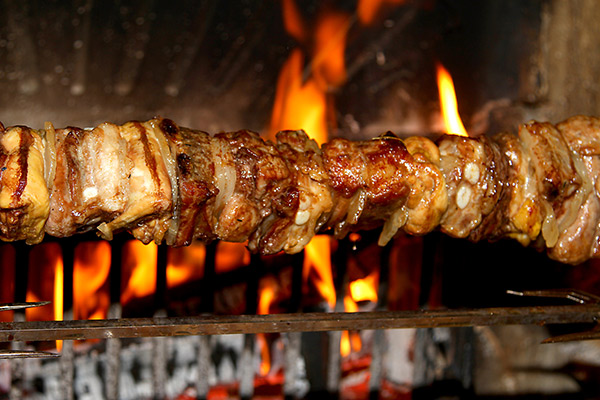
If you’re thinking of innovative ways to spice up your meals, you may be wondering, “can I cook in my fireplace?” The simple answer is that, in most cases, you can! If you’re a fan of the outdoors, you may already be familiar with open-fire cooking. Many of these skills translate perfectly into cooking with your indoor fireplace, and offer you the ability to cook food with a unique flavor unachievable with modern cooking appliances. Read on to learn more about cooking in your home’s fireplace.
One Caveat: Never Cook in a Gas Fireplace!
While cooking in a well-maintained wood-burning fireplace is perfectly safe, you should never cook in a gas fireplace. The most important reason is that your gas logs need to stay clean and unobstructed to properly work. Grease or other food particles could easily fall onto the logs causing them to not function properly. In some cases, you could even create a dangerous fire hazard.
Additionally, chemicals in the gas will get into the food you’re eating, which isn’t ideal. If you’re interested in cooking over an open flame, you’ll need to stick to wood-burning fireplaces!
Cooking in an Indoor Fireplace
The first step to cooking in your fireplace is to figure out which method will work best for you:
Using a Skewer
A skewer is a tried-and-true method for open-flame cooking that works just as well inside your home as it does at a campfire. From marshmallows to meat, there are plenty of choices for what to put on your skewer. Using them is simple. Pierce your food with the skewer and make sure it’s secure. Then simply hold the food over the fire and rotate the skewer to keep the heat even.
Using a Dutch Oven
If you have a Dutch oven, you can easily cook stews or soups in your fireplace! The trick to Dutch oven fireplace cooking is to get a fire going that produces plenty of hot embers. Once it’s ready, you can put a full Dutch oven on the embers. Top it with more embers and remember to periodically rotate it to evenly distribute the heat. You’ll have a delicious stew cooked in no time!
À la Ficelle (On a String)
This classic French technique requires you to be able to hang a hook or nail directly above the fire. It’s a great option for cooking larger meats that might take time and are too big to use a skewer. Once you have the hook in place, take your food and tie it with kitchen twine. If you’re cooking with chicken or a roast, make sure to tie it so that the string will hang it upright. Then simply hang it up and start the fire!
You’ll want to occasionally spin your meal as it cooks, and just a light tap is all it will take. Also keep in mind that for bigger meats, you may need to re-baste or wet the twine to prevent it from drying out and breaking.
Important Safety for Cooking in an Indoor Fireplace
The most important part of cooking in your fireplace is opening the flue. When you cook in an indoor fireplace, it will take some time; leaving the flue closed will quickly expose you to a buildup of carbon monoxide that can be dangerous to your health.
You will also need to move any flammable items away from your fireplace. Ideally, you aren’t keeping them nearby already. Since you’ll frequently be opening the screen and interacting with the fire, it becomes even more important not to have anything potentially flammable nearby.
It's also critical that you always maintain your fireplace and chimney. Cooking in an uncleaned fireplace or chimney can introduce you to fire or smoke risks. Even if you never use your fireplace, or only use it a few times per year, you should schedule regular chimney inspections to prevent damage to your well-being or your home!
Tips for Cooking with Your Wood Burning Fireplace
#1. Avoid Foods with a Lot of Fat
Fatty foods like rib eye steak will create a lot of smoke when you cook them over the fire. You likely won’t enjoy cooking as much when dealing with that cloud of smoke, and it also affects your flue. That extra smoke can create build-up in your flue, leading to other risks down the road.
#2. Choose the Right Wood
The wood you use will impact the taste of any food you cook over an open wood flame. That’s why it’s important to make sure that you use the right kind of wood for your tastes. Well-seasoned hardwoods like apple wood will give you a unique flavor to enjoy that you can’t get from regular stove or oven cooking. They’re also less likely to throw off dangerous sparks.
Take advantage of cooking over wood to experiment with different types of wood! Just make sure to avoid pine or cedar – they burn at low temperatures and will leave resin in your chimney. Likewise, don’t use standard wood logs like Duraflame logs. Many of these include things like petroleum wax that will get into your food, affecting the taste and possibly even making you ill.
#3. Test for Temperature
Cooking in a fireplace can be difficult. Heat distributes unevenly, especially compared to an oven. When you’re cooking meats, it’s important to pay close attention to the temperature. You may end up with parts of your food that are a little overcooked – and that’s okay, because it’s better than eating undercooked food.
#4. Place a Pan or Tray to Catch Drips
No matter what you’re cooking, it’s likely that you’ll have grease or similar drips. If you place a tray or roasting pan underneath your food, you can save yourself extra cleanup steps. You’ll also reduce the smoke produced by the fire.
Planning to Cook in Your Fireplace? Schedule a CSIA-Certified Chimney Inspection First!
We can thoroughly clean and inspect your fireplace and chimney to identify any damage or safety concerns. Contact us today so you can have peace of mind.
Call Us: 1-800-438-3583
Email Us: office@drflue.com
Office Hours: Mon-Fri: 8am-4pm
Connect with Doctor Flue on Social Media

